Historic City Centre
Oldenburg's Sightseeing Highlights at the Historic City Centre
Visitors to Oldenburg's enchanting historic city centre will enjoy a tour of its sightseeing highlights. Stroll through Germany's oldest large-area pedestrian zone, enjoy the grandeur of the residential palace or a walk along the arm of the river Hunte – there is a lot to be explored!
Our interactive city map will help you plan your tour around Oldenburg's sights. Please click on the following link to get to the city map »
Former Military Barracks at the Pferdemarkt
Lappan
PFL Culture Centre
The PFL Municipal Culture Centre, housed in the late classicist former Peter Friedrich Ludwigs Hospital in the Peterstraße built 1838 - 1841, is one of the architectural highlights of the Oldenburg cityscape. The three-wing building with its 65 metre front, the six-section column portico and numerous outer buildings looks very impressive. It makes you forget that the elegantly curved driveway once led to the entrance of a hospital. The house ultimately became too small for its original purpose. When the Municipal Clinics moved out in 1984, the listed complex was renovated and equipped for cultural purposes.
Peterstraße 3
26121 Oldenburg
Oldenburg State Theatre
Degode House
Dated 1617, the Degode House – named after the Degode merchant family - with its eye-catching, overhanging roof construction is one of the oldest surviving buildings in the city. The interior of this half-timbered house features a beautiful painted wooden ceiling.
Markt 24
26122 Oldenburg
Pulverturm
The last surviving building is the Pulverturm, the Powder Tower, a reminder of the former city fortifications of Oldenburg. Remnants of the city wall can be seen at the side of the tower, which was built in 1529. It was actually used for storing powder under Danish rule between 1730 and 1765. The city fortifications were torn down 200 years after the tower was built. The tower survived as it was used for storing ice for cooling the food from the court kitchens. The Pulverturm is now often used for art exhibitions.
Am Schlosswall
26123 Oldenburg
Old Town Hall
The Old Town Hall (Altes Rathaus), built in 1888, is regarded as the most original building from the Gründerzeit, also due to its triangular form. It is still home to the offices of the Lord Mayor and to the political parties of the city council today.
Oldenburg’s town hall tradition goes back to the year 1345, when it was officially named a city. The first town hall was a fairly small gothic brick building with a stepped gable, located at the city’s market place. In 1635 it got replaced by an architecturally convincing renaissance building with decorative gables and ornaments. By mid-19th century the town hall couldn’t satisfy the needs of the growing city anymore. In August 1883 the city council voted in favour of a new town hall – by a majority of one.
Stylistically, the Old Town Hall is a brick building in eclecticist architecture, that combines elements of neo renaissance and neo gothic. In other words: It features design elements from different ages – and it looks older than it actually is. It also features an architectural rarity: the floor plan is exactly triangular. The town hall was designed by the renowned architects Zaar & von Holst from Berlin. The total cost of the Old Town Hall was 150,000 Goldmarks - in comparable prices approx. 1,480,000 Euro.
The Old Town Hall is also famous for its Glockenspiel. It was installed to commemorate 650 years of city rights in 1995. Since then the bells are ringing four times a day: 11:00, 14:00, 17:00 and 19:00. The songs played include a collection of seasonal tunes as well as the “Oldenburg Hymn” from 1844.
Markt 1
26122 Oldenburg
Lamberti Church
A neo-Gothic hall church on the outside, a classicist rotunda on the inside - the Lamberti church is a particularly fascinating building. This Protestant church was built in its original form in around 1200. In 1795 the church was demolished except for its outer walls, and the round church with its glass dome was built inside. The church tower and the four square towers were not added until 1885 to 1887.
Markt 17
26122 Oldenburg
Palace Guardhouse
Oldenburg Palace
The site of the splendid Oldenburg palace used to be the location of a moated castle. The palace as it now stands was built by Count Anton Günther (1583-1667). From 1607 to 1615 he had the medieval-style castle converted into a splendid Renaissance-style palace. From then on it served as the residence of all counts and grand dukes of the city.
The appearance of the palace also changed frequently in the following centuries. During the period of Danish rule from 1737 to 1753 the palace underwent a great deal of conversion work: The shape of the roof was changed, the tower entrance was closed and a main gate was built instead. In addition a north-east wing was built from 1774 to 1778. It served to house the Danish governor and minister Friedrich Lewin Graf Holmer. Duke Friedrich August probably named this wing the "Holmerflügel" after him. His successor Duke Peter Ludwig had the two-floor "library wing" built and had the inside of the palace refurbished by the court painter Heinrich Wilhelm Tischbein (1751-1829) in a classicist style. In 1894 the dilapidated "Kanzlei-Flügel" was torn down.
Since 1921 the Oldenburg palace has been part of the Federal State Museum for Art and Art History »
Schlossplatz
26122 Oldenburg
Prince's Palace
Pedestrian Zone
The pedestrian zone in Oldenburg is one of the oldest large-area pedestrian zones in Germany. It was created in 1967 while many other cities and towns only had isolated car-free streets. The pedestrian zone is a pleasing mix of historical buildings, small alleys, a varied range of owner-run shops and an exciting selection of cafes and eateries. The Wallstrasse is known as Oldenburg's "pub mile".
Cäcilienbrücke
The Cäcilienbrücke is a very special route over the Hunte river. The bridge can be elevated by several metres to let ships pass. Pedestrians can continue on their way without having to wait, as a new path opens through the passages of the bridge towers. The original drawbridge at this location was built in 1832 by Grand Duke Paul Friedrich August, who named it after his wife Cäcilie.
Damm
26135 Oldenburg
The River Hunte
Oldenburg is also called the "Huntestadt", the city on the Hunte. With its two arms, the Hunte, a tributary of the Weser, is a main feature of the city.
The so-called Alte Hunte flows near the city centre pedestrian zone past the palace gardens and flows into the old harbour below the Stautor. Visitors to the OLantis baths can even swim in the so-called "Old Hunte".
The river bed of the "New Hunte" was constructed as part of the work on the coastal canal, the Küstenkanal. The coastal canal is 70 kilometres long and connects the Dortmund-Ems canal with the Hunte and therefore the Weser. The New Hunte rejoins the Old Hunte below the Wendehafen.
Zuletzt geändert am 7. Februar 2024





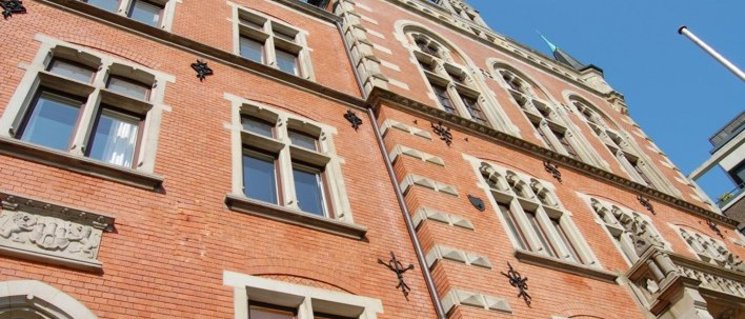
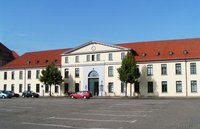
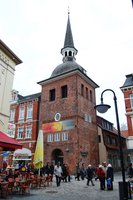
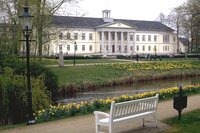
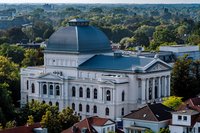
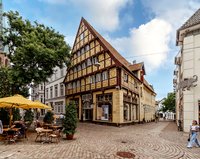

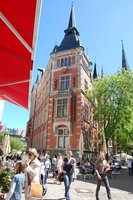
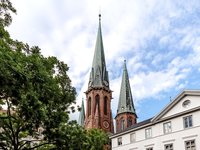
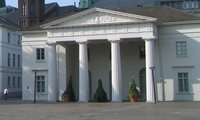
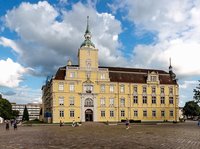
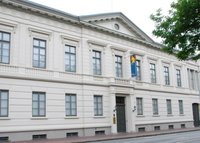
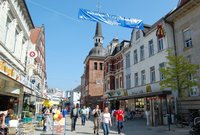
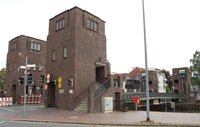
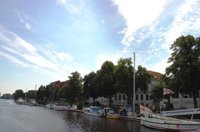
 zurück
zurück